Abstract
A full-length cDNA clone (1,894 nucleotides) of mouse cytochrome P3-450 was isolated with the Okayama-Berg vector and sequenced. An open reading frame spanned positions 61 to 1602. The first 25, and three of the last five, amino acids of P3-450 are identical to those found in the amino- and carboxy-terminus, respectively, of the rat P-450d protein. Mouse P3-450 protein has 513 residues, and a molecular weight of 58,223 with six cysteine residues. P3-450 nucleotides 305 to 352 exhibit 74% homology, and nucleotides 1068 to 1260, 69% homology, with portions of rat P-450b exons 2 and 7, respectively. P3-450 shows 62% homology in the so-called "highly conserved region" of 39 nucleotides in the rat P-450b and P-450e and the mouse P-450b. These results indicate that P3-450, P-450b and P-450e arose from a common ancestral gene. Cysteinyl peptide-coding regions were examined: P3-450 nucleotides 1405 to 1464 exhibit 61% homology, and nucleotides 502 to 552 exhibit 37% homology, when compared with their corresponding regions in the rat P-450b gene. These data support the likelihood that cysteine 456 is the thiolate ligand to the heme iron in the P3-450 enzyme active-site.
Full text
PDF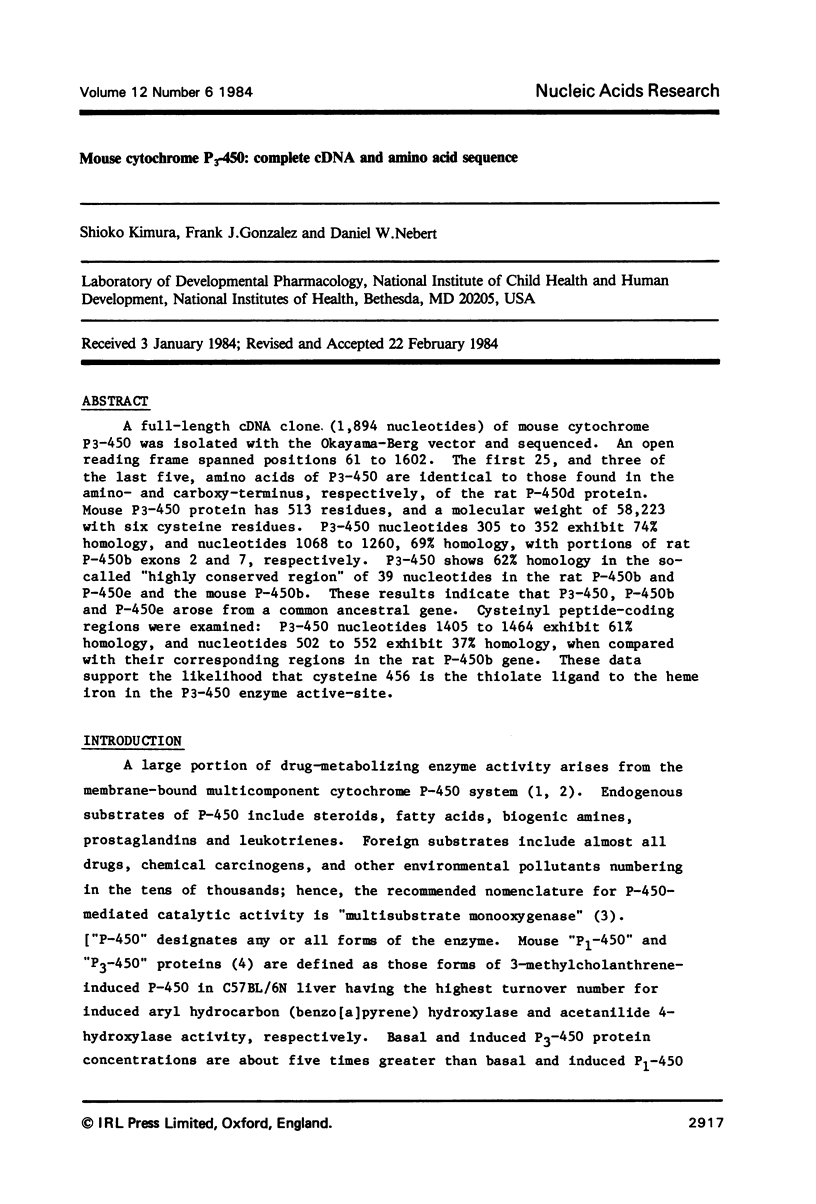
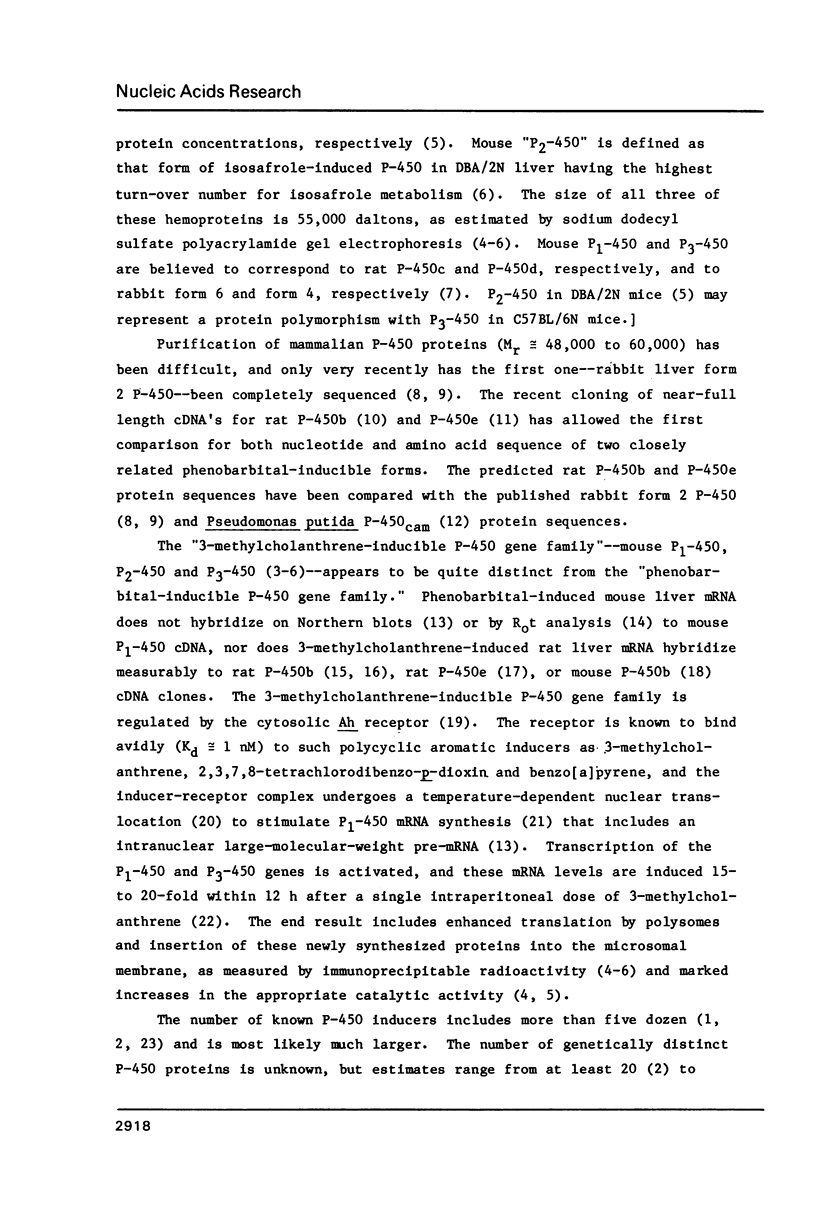
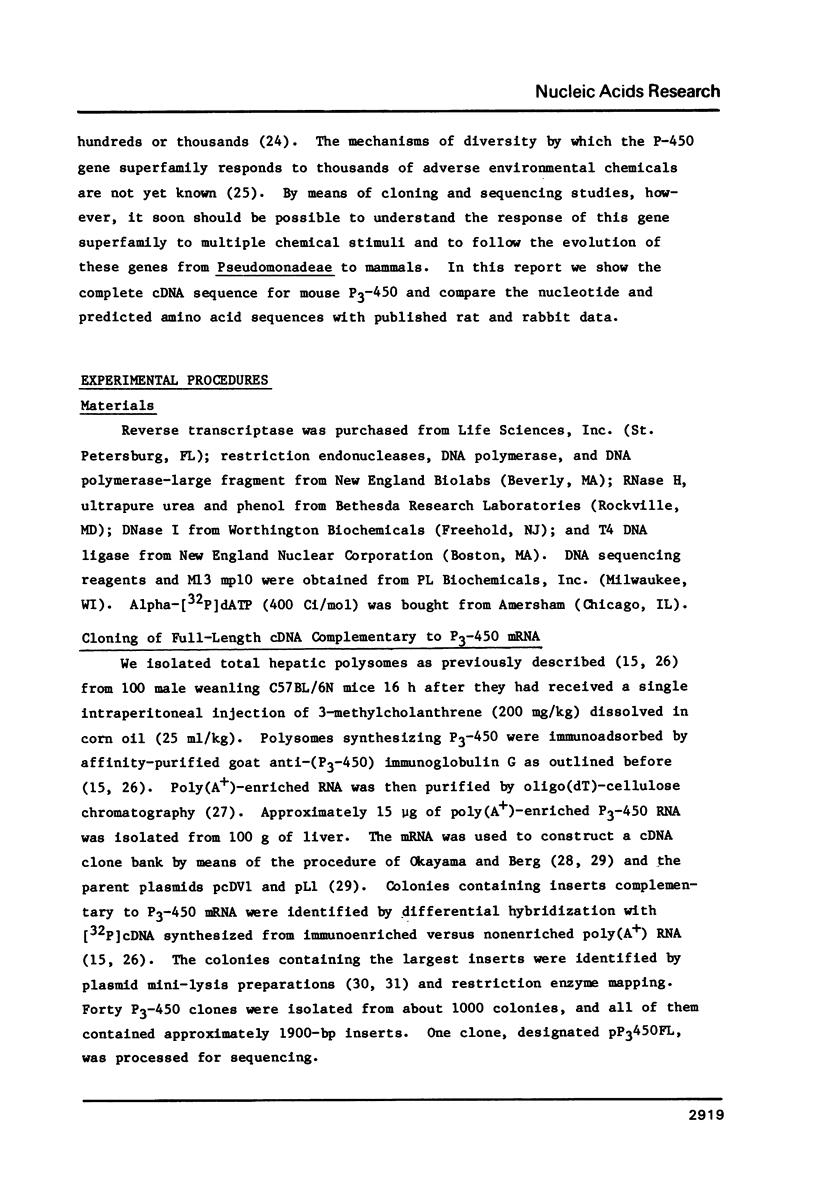

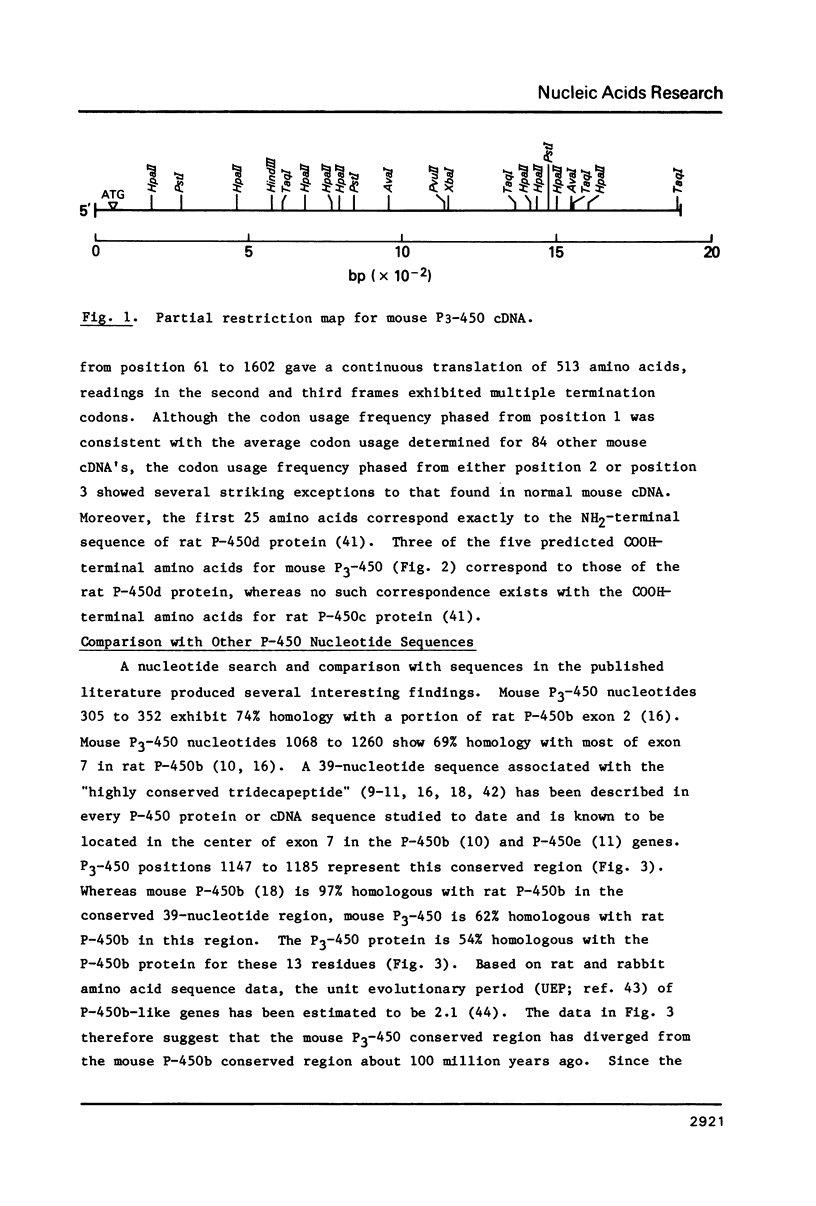
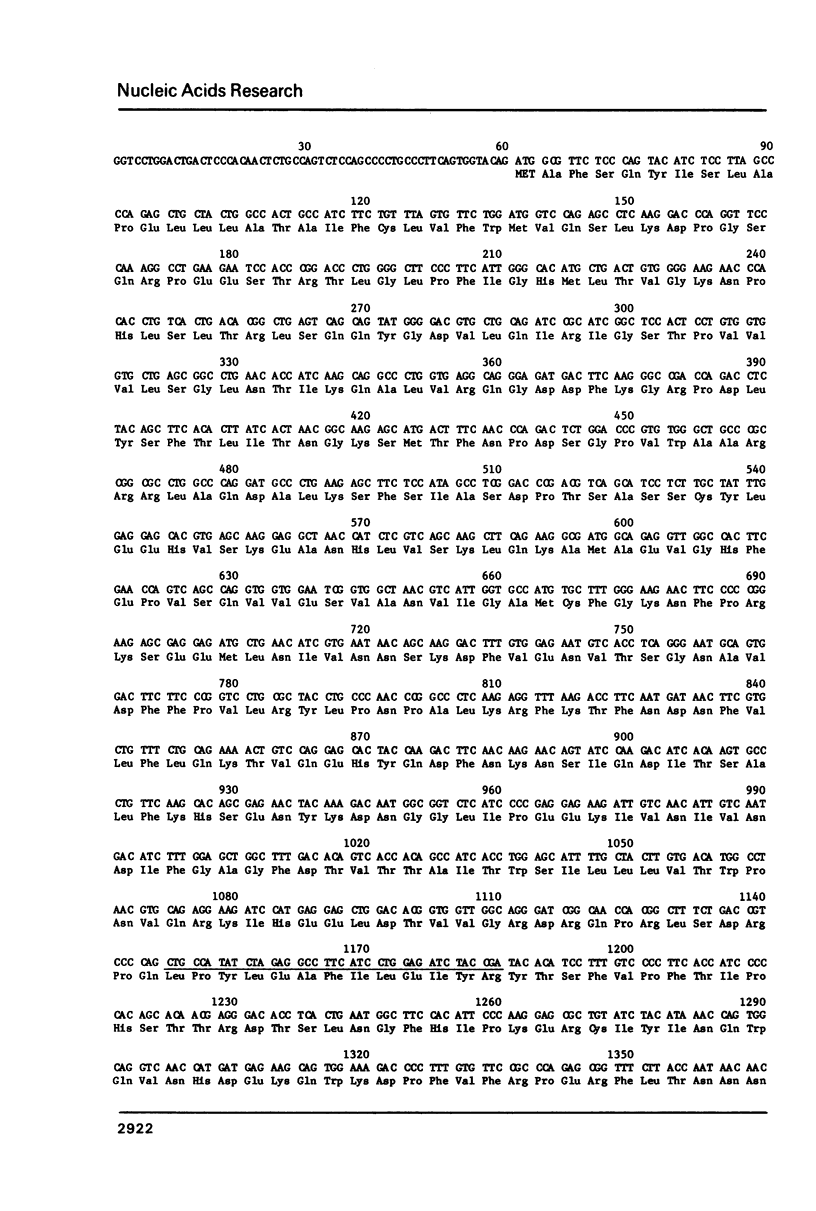
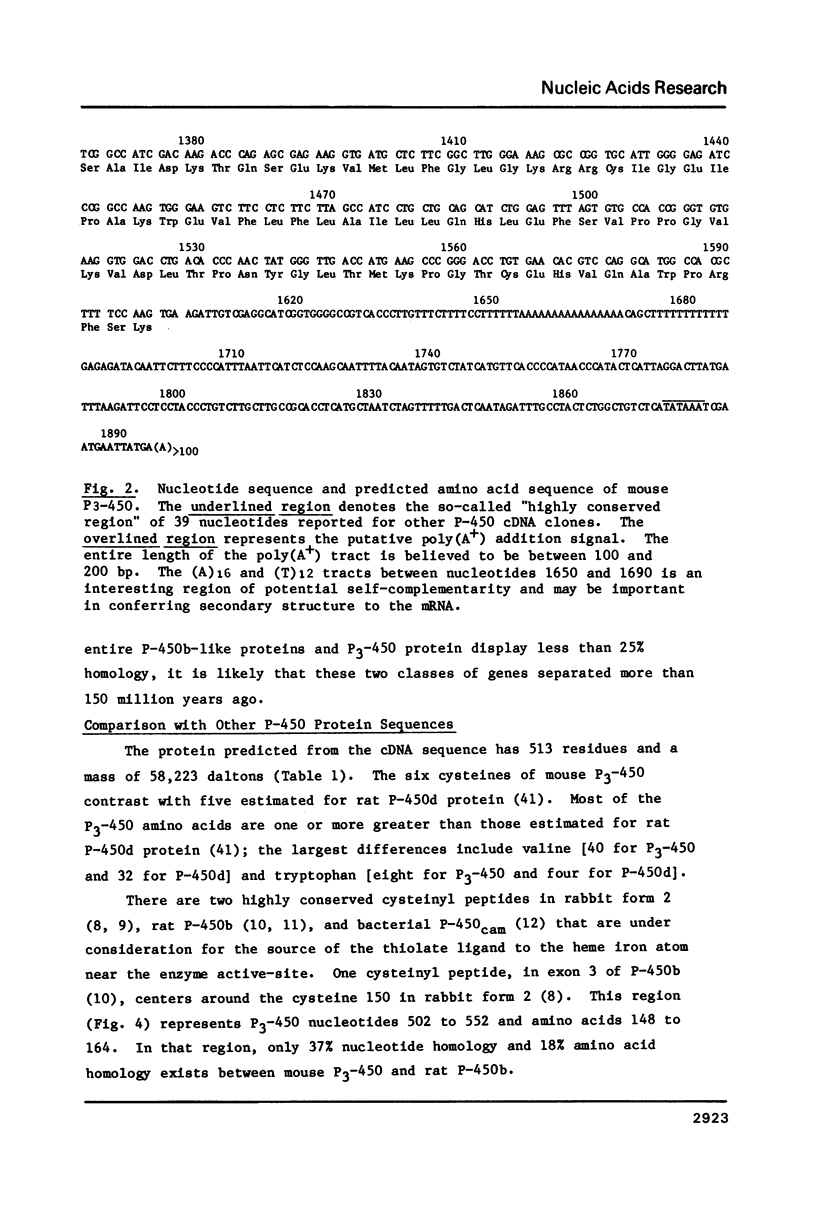
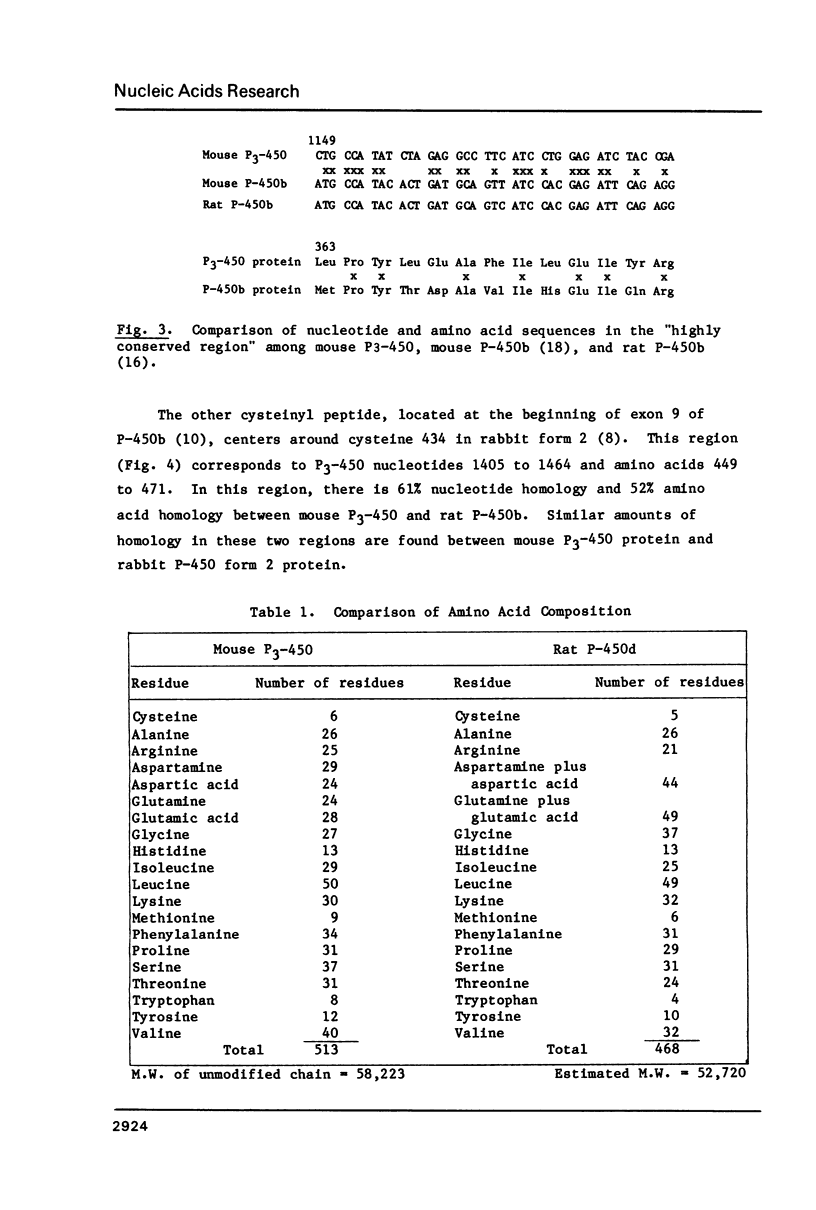
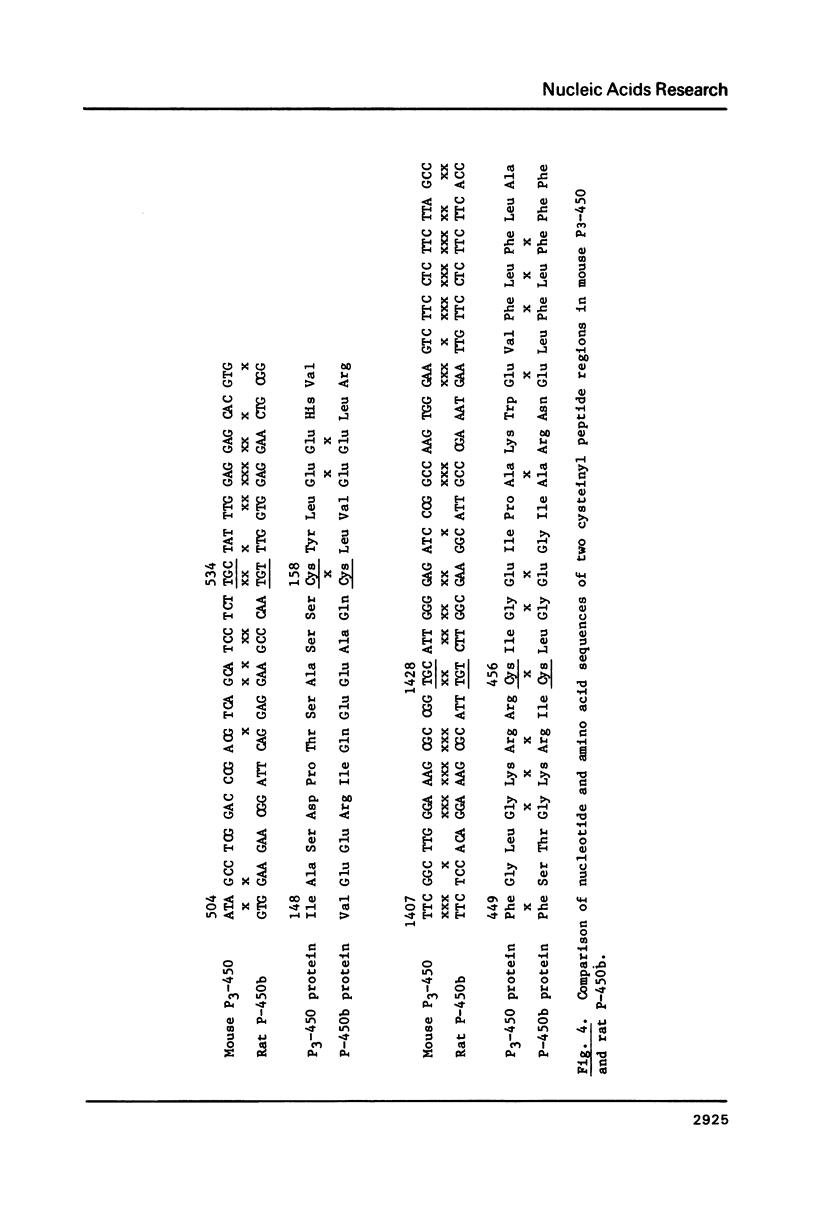
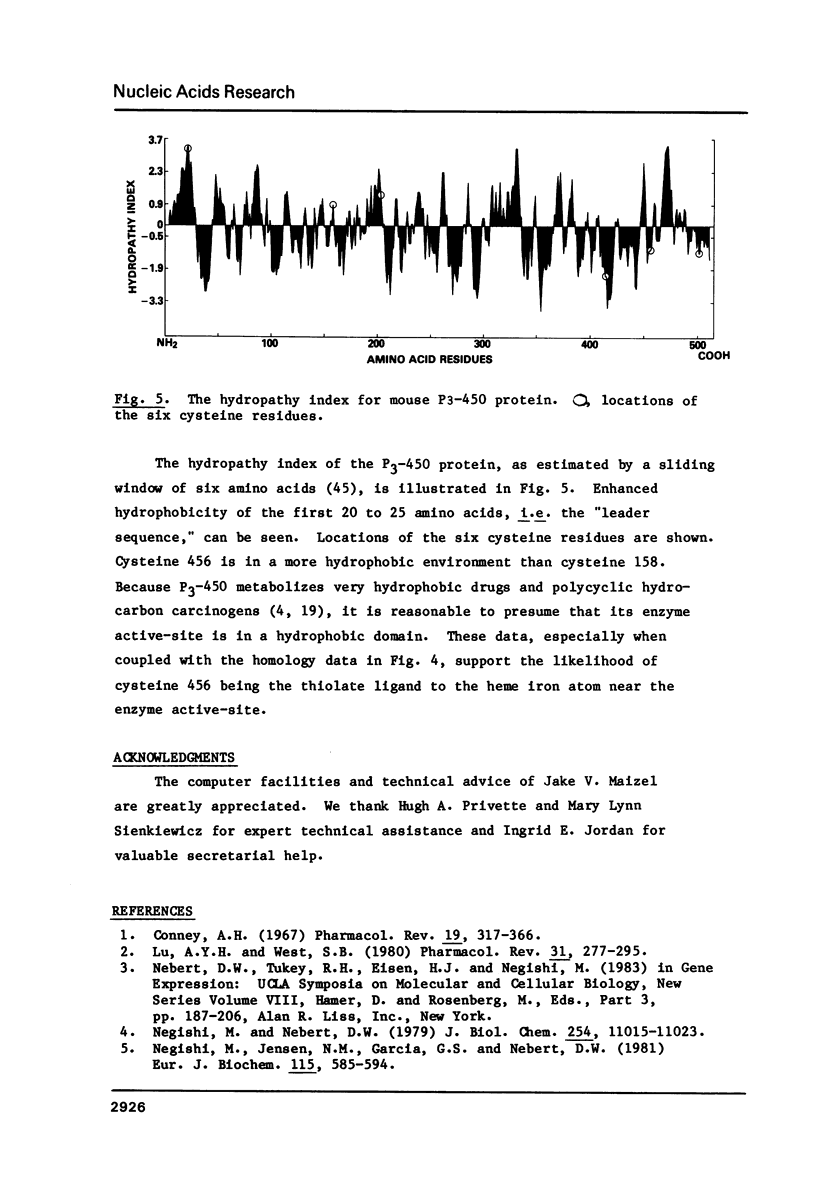
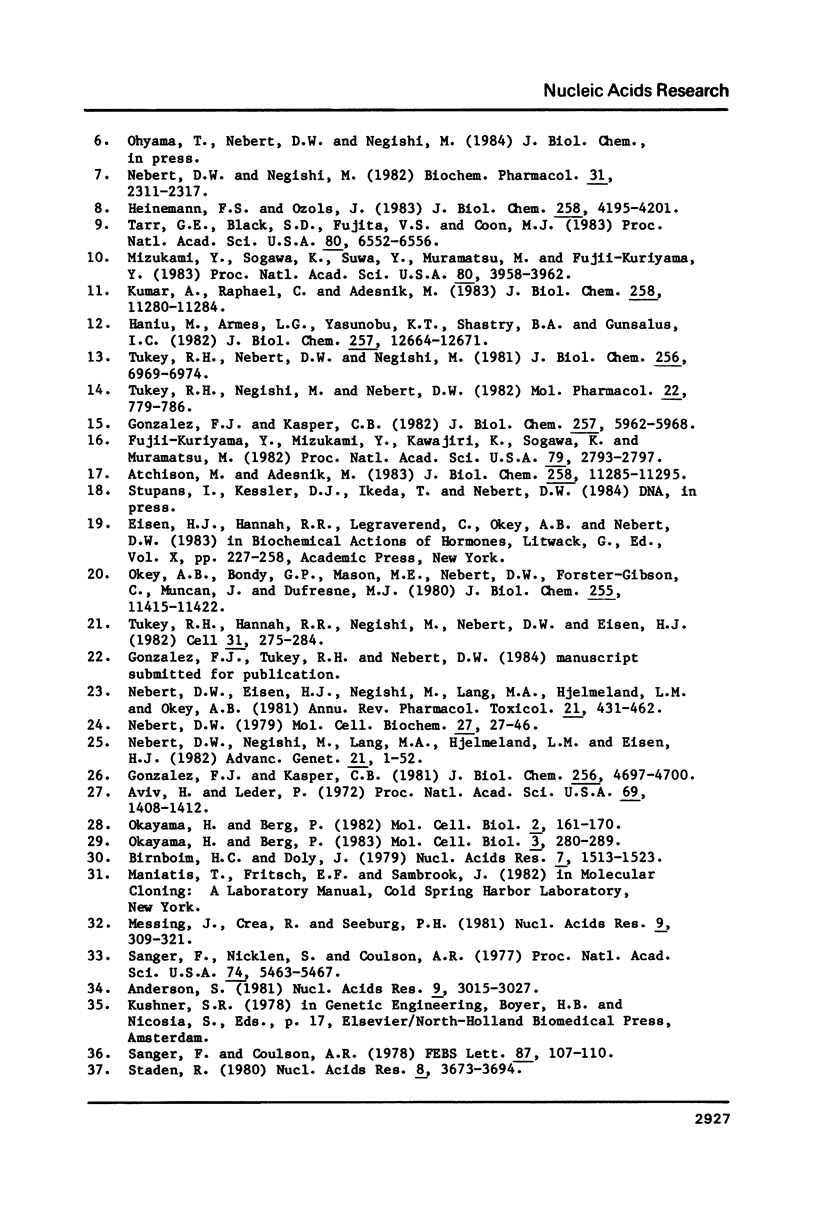
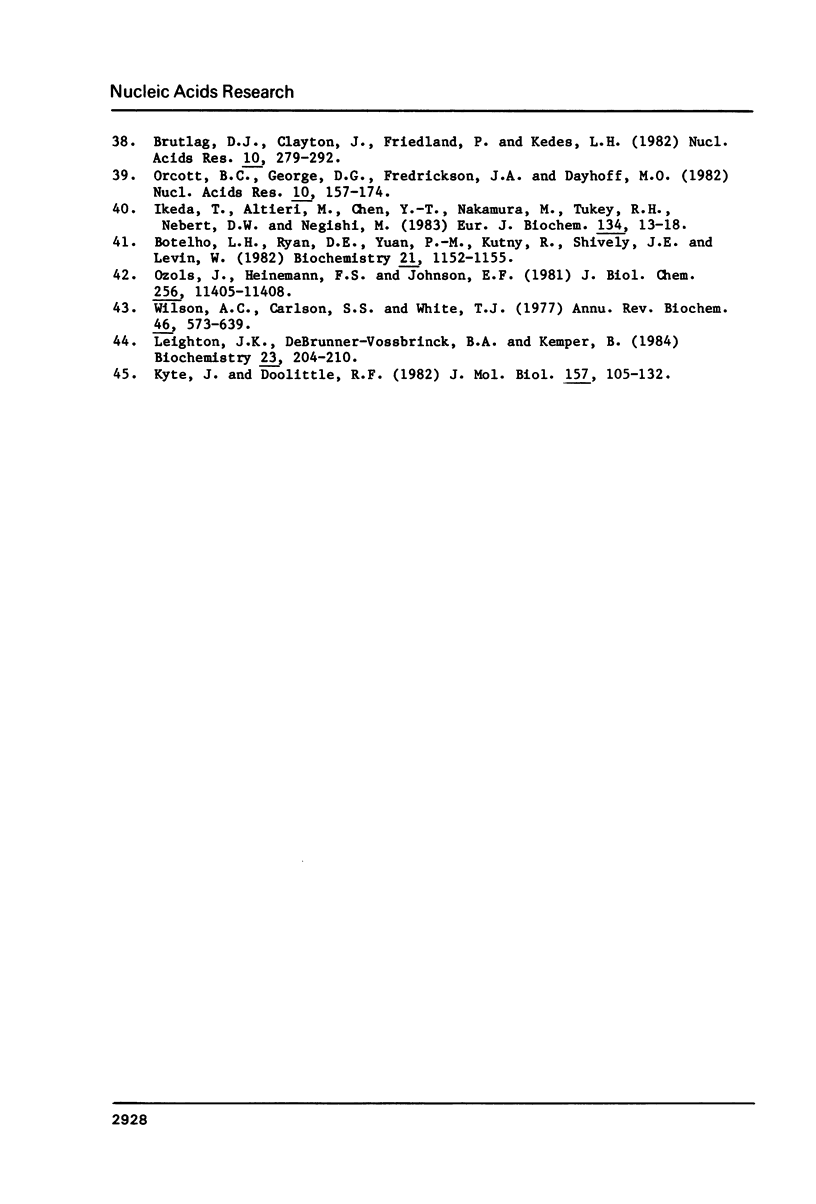
Selected References
These references are in PubMed. This may not be the complete list of references from this article.
- Anderson S. Shotgun DNA sequencing using cloned DNase I-generated fragments. Nucleic Acids Res. 1981 Jul 10;9(13):3015–3027. doi: 10.1093/nar/9.13.3015. [DOI] [PMC free article] [PubMed] [Google Scholar]
- Atchison M., Adesnik M. A cytochrome P-450 multigene family. Characterization of a gene activated by phenobarbital administration. J Biol Chem. 1983 Sep 25;258(18):11285–11295. [PubMed] [Google Scholar]
- Aviv H., Leder P. Purification of biologically active globin messenger RNA by chromatography on oligothymidylic acid-cellulose. Proc Natl Acad Sci U S A. 1972 Jun;69(6):1408–1412. doi: 10.1073/pnas.69.6.1408. [DOI] [PMC free article] [PubMed] [Google Scholar]
- Birnboim H. C., Doly J. A rapid alkaline extraction procedure for screening recombinant plasmid DNA. Nucleic Acids Res. 1979 Nov 24;7(6):1513–1523. doi: 10.1093/nar/7.6.1513. [DOI] [PMC free article] [PubMed] [Google Scholar]
- Botelho L. H., Ryan D. E., Yuan P. M., Kutny R., Shively J. E., Levin W. Amino-terminal and carboxy-terminal sequence of hepatic microsomal cytochrome P-450d, a unique hemoprotein from rats treated with isosafrole. Biochemistry. 1982 Mar 16;21(6):1152–1155. doi: 10.1021/bi00535a007. [DOI] [PubMed] [Google Scholar]
- Brutlag D. L., Clayton J., Friedland P., Kedes L. H. SEQ: a nucleotide sequence analysis and recombination system. Nucleic Acids Res. 1982 Jan 11;10(1):279–294. doi: 10.1093/nar/10.1.279. [DOI] [PMC free article] [PubMed] [Google Scholar]
- Conney A. H. Pharmacological implications of microsomal enzyme induction. Pharmacol Rev. 1967 Sep;19(3):317–366. [PubMed] [Google Scholar]
- Fujii-Kuriyama Y., Mizukami Y., Kawajiri K., Sogawa K., Muramatsu M. Primary structure of a cytochrome P-450: coding nucleotide sequence of phenobarbital-inducible cytochrome P-450 cDNA from rat liver. Proc Natl Acad Sci U S A. 1982 May;79(9):2793–2797. doi: 10.1073/pnas.79.9.2793. [DOI] [PMC free article] [PubMed] [Google Scholar]
- Gonzalez F. J., Kasper C. B. Cloning of DNA complementary to rat liver NADPH-cytochrome c (P-450) oxidoreductase and cytochrome P-450b mRNAs. Evidence that phenobarbital augments transcription of specific genes. J Biol Chem. 1982 May 25;257(10):5962–5968. [PubMed] [Google Scholar]
- Gonzalez F. J., Kasper C. B. Cloning of epoxide hydratase complementary DNA. J Biol Chem. 1981 May 25;256(10):4697–4700. [PubMed] [Google Scholar]
- Haniu M., Armes L. G., Yasunobu K. T., Shastry B. A., Gunsalus I. C. Amino acid sequence of the Pseudomonas putida cytochrome P-450. II. Cyanogen bromide peptides, acid cleavage peptides, and the complete sequence. J Biol Chem. 1982 Nov 10;257(21):12664–12671. [PubMed] [Google Scholar]
- Heinemann F. S., Ozols J. The complete amino acid sequence of rabbit phenobarbital-induced liver microsomal cytochrome P-450. J Biol Chem. 1983 Apr 10;258(7):4195–4201. [PubMed] [Google Scholar]
- Ikeda T., Altieri M., Chen Y. T., Nakamura M., Tukey R. H., Nebert D. W., Negishi M. Characterization of cytochrome P2-450 (20-S) mRNA. Association with the P1-450 genomic gene and differential response to the inducers 3-methylcholanthrene and isosafrole. Eur J Biochem. 1983 Jul 15;134(1):13–18. doi: 10.1111/j.1432-1033.1983.tb07524.x. [DOI] [PubMed] [Google Scholar]
- Kumar A., Raphael C., Adesnik M. Cloned cytochrome P-450 cDNA. Nucleotide sequence and homology to multiple phenobarbital-induced mRNA species. J Biol Chem. 1983 Sep 25;258(18):11280–11284. [PubMed] [Google Scholar]
- Kyte J., Doolittle R. F. A simple method for displaying the hydropathic character of a protein. J Mol Biol. 1982 May 5;157(1):105–132. doi: 10.1016/0022-2836(82)90515-0. [DOI] [PubMed] [Google Scholar]
- Leighton J. K., DeBrunner-Vossbrinck B. A., Kemper B. Isolation and sequence analysis of three cloned cDNAs for rabbit liver proteins that are related to rabbit cytochrome P-450 (form 2), the major phenobarbital-inducible form. Biochemistry. 1984 Jan 17;23(2):204–210. doi: 10.1021/bi00297a005. [DOI] [PubMed] [Google Scholar]
- Lu A. Y., West S. B. Multiplicity of mammalian microsomal cytochromes P-45. Pharmacol Rev. 1979 Dec;31(4):277–295. [PubMed] [Google Scholar]
- Messing J., Crea R., Seeburg P. H. A system for shotgun DNA sequencing. Nucleic Acids Res. 1981 Jan 24;9(2):309–321. doi: 10.1093/nar/9.2.309. [DOI] [PMC free article] [PubMed] [Google Scholar]
- Mizukami Y., Sogawa K., Suwa Y., Muramatsu M., Fujii-Kuriyama Y. Gene structure of a phenobarbital-inducible cytochrome P-450 in rat liver. Proc Natl Acad Sci U S A. 1983 Jul;80(13):3958–3962. doi: 10.1073/pnas.80.13.3958. [DOI] [PMC free article] [PubMed] [Google Scholar]
- Nebert D. W., Eisen H. J., Negishi M., Lang M. A., Hjelmeland L. M., Okey A. B. Genetic mechanisms controlling the induction of polysubstrate monooxygenase (P-450) activities. Annu Rev Pharmacol Toxicol. 1981;21:431–462. doi: 10.1146/annurev.pa.21.040181.002243. [DOI] [PubMed] [Google Scholar]
- Nebert D. W. Multiple forms of inducible drug-metabolizing enzymes: a reasonable mechanism by which any organism can cope with adversity. Mol Cell Biochem. 1979 Sep 28;27(1):27–46. doi: 10.1007/BF00849277. [DOI] [PubMed] [Google Scholar]
- Nebert D. W., Negishi M., Lang M. A., Hjelmeland L. M., Eisen H. J. The Ah locus, a multigene family necessary for survival in a chemically adverse environment: comparison with the immune system. Adv Genet. 1982;21:1–52. doi: 10.1016/s0065-2660(08)60296-5. [DOI] [PubMed] [Google Scholar]
- Nebert D. W., Negishi M. Multiple forms of cytochrome P-450 and the importance of molecular biology and evolution. Biochem Pharmacol. 1982 Jul 15;31(14):2311–2317. doi: 10.1016/0006-2952(82)90523-8. [DOI] [PubMed] [Google Scholar]
- Negishi M., Jensen N. M., Garcia G. S., Nebert D. W. Structural gene products of the murine Ah complex. Differences in ontogenesis and glucosamine incorporation between liver microsomal cytochromes P1-450 and P-448 induced by polycyclic aromatic compounds. Eur J Biochem. 1981 Apr;115(3):585–594. [PubMed] [Google Scholar]
- Negishi M., Nebert D. W. Structural gene products of the Ah locus. Genetic and immunochemical evidence for two forms of mouse liver cytochrome P-450 induced by 3-methylcholanthrene. J Biol Chem. 1979 Nov 10;254(21):11015–11023. [PubMed] [Google Scholar]
- Okayama H., Berg P. A cDNA cloning vector that permits expression of cDNA inserts in mammalian cells. Mol Cell Biol. 1983 Feb;3(2):280–289. doi: 10.1128/mcb.3.2.280. [DOI] [PMC free article] [PubMed] [Google Scholar]
- Okayama H., Berg P. High-efficiency cloning of full-length cDNA. Mol Cell Biol. 1982 Feb;2(2):161–170. doi: 10.1128/mcb.2.2.161. [DOI] [PMC free article] [PubMed] [Google Scholar]
- Okey A. B., Bondy G. P., Mason M. E., Nebert D. W., Forster-Gibson C. J., Muncan J., Dufresne M. J. Temperature-dependent cytosol-to-nucleus translocation of the Ah receptor for 2,3,7,8-tetrachlorodibenzo-p-dioxin in continuous cell culture lines. J Biol Chem. 1980 Dec 10;255(23):11415–11422. [PubMed] [Google Scholar]
- Orcutt B. C., George D. G., Fredrickson J. A., Dayhoff M. O. Nucleic acid sequence database computer system. Nucleic Acids Res. 1982 Jan 11;10(1):157–174. doi: 10.1093/nar/10.1.157. [DOI] [PMC free article] [PubMed] [Google Scholar]
- Ozols J., Heinemann F. S., Johnson E. F. Amino acid sequence of an analogous peptide from two forms of cytochrome P-450. J Biol Chem. 1981 Nov 25;256(22):11405–11408. [PubMed] [Google Scholar]
- Sanger F., Coulson A. R. The use of thin acrylamide gels for DNA sequencing. FEBS Lett. 1978 Mar 1;87(1):107–110. doi: 10.1016/0014-5793(78)80145-8. [DOI] [PubMed] [Google Scholar]
- Sanger F., Nicklen S., Coulson A. R. DNA sequencing with chain-terminating inhibitors. Proc Natl Acad Sci U S A. 1977 Dec;74(12):5463–5467. doi: 10.1073/pnas.74.12.5463. [DOI] [PMC free article] [PubMed] [Google Scholar]
- Staden R. A new computer method for the storage and manipulation of DNA gel reading data. Nucleic Acids Res. 1980 Aug 25;8(16):3673–3694. doi: 10.1093/nar/8.16.3673. [DOI] [PMC free article] [PubMed] [Google Scholar]
- Tarr G. E., Black S. D., Fujita V. S., Coon M. J. Complete amino acid sequence and predicted membrane topology of phenobarbital-induced cytochrome P-450 (isozyme 2) from rabbit liver microsomes. Proc Natl Acad Sci U S A. 1983 Nov;80(21):6552–6556. doi: 10.1073/pnas.80.21.6552. [DOI] [PMC free article] [PubMed] [Google Scholar]
- Tukey R. H., Hannah R. R., Negishi M., Nebert D. W., Eisen H. J. The Ah locus: correlation of intranuclear appearance of inducer-receptor complex with induction of cytochrome P1-450 mRNA. Cell. 1982 Nov;31(1):275–284. doi: 10.1016/0092-8674(82)90427-5. [DOI] [PubMed] [Google Scholar]
- Tukey R. H., Nebert D. W., Negishi M. Structural gene product of the [Ah] complex. Evidence for transcriptional control of cytochrome P1-450 induction by use of a cloned DNA sequence. J Biol Chem. 1981 Jul 10;256(13):6969–6974. [PubMed] [Google Scholar]
- Tukey R. H., Negishi M., Nebert D. W. Quantitation of hepatic cytochrome P1-450 mRNA with the use of a cloned DNA probe. Effects of various P-450 inducers in C57BL/6N and DBA/2N mice. Mol Pharmacol. 1982 Nov;22(3):779–786. [PubMed] [Google Scholar]
- Wilson A. C., Carlson S. S., White T. J. Biochemical evolution. Annu Rev Biochem. 1977;46:573–639. doi: 10.1146/annurev.bi.46.070177.003041. [DOI] [PubMed] [Google Scholar]


